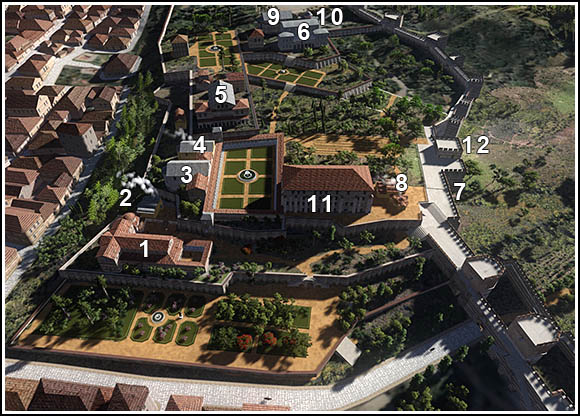 |
| Ancient Greek temple architecture, used a lot in my games |
That the place was laid out like a late Tudor manor house. It felt more like Downton Abbey than it did a medieval fortalice. There were lots of hallways and rooms that branched off of them. There were big hallways that served no function other than to impress those coming through them. I was asked by a player as I described the entrance hall: "Are there any trestle tables in here?" Stunned, I answered no. Why did he react that way? Because for five years I've been totally insulated from old D&D standards and designing all of my buildings based on medieval and ancient floorplans.
These are the models I've been working off of, and it has been hard as hell. I only now realize why I've been struggling to design dungeons that are varied, interesting, and challenging: they were never meant to be designed as though they were the ruins of real ancient structures. But nevertheless, I've managed to create my own lingo of dungeon, castle, palace, and temple design based on ancient sources. Most temples, for example, are either hypostyle halls or tholoi in the 10th Age. This means that there are no twisting corridors or back rooms: there is an exterior pediment, an interior space, and a sanctum sanctorum. Anything else I have been putting underground because it simply doesn't fit in the layout of an ancient temple.
 |
| Tholos type temple construction |
 |
| Hypostyle hall (Egyptian) with egyptian/early Milean pillars |
Of course, I also use a lot of medieval stuff as well; manor houses and the like are based off of real medieval models. Depending on the technology level of the civilization and the flavor, these may be of varying designs. Trade Sea style halls tend towards mediterranean villas (though there are a number of "manor" type houses in the Milean Empire as well).
 |
| Low-tech (Weylish, Cymballene) manor house |
I know that there's no real NEED to have very historically accurate things such as these dot the landscape. But I LIKE designing them that way. These intricate many-halled buildings that populate adventures and town layouts are reserved for the mighty palaces of great rulers. Most humble barons would have access to the more simple structures I've shown here.
Yes, it is fantasy. Yes, I want to add a fantastic element. But I also prefer the fantastic grounded in the historical, using history as a foundation. Places like the Imperial Domus are much more like the many-roomed Tower of Ashaba... but they are the exception, not the rule. They are the Palaces of the Blachernae, not the domains of local lords.
 |
| Blachernae, the home of the Byzantine emperors |



No comments:
Post a Comment